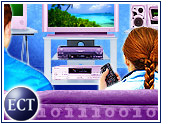
Promoted as a way to foster digital television but derided as a halfhearted antipiracy measure that caters mainly to Hollywood, a new mechanism known as the “broadcast flag” has been adopted by the Federal Communications Commission. The FCC will require the copy-control measure to be built into all digital television-capable devices by July 1, 2005.
The FCC adoption, approved unanimously with only partial dissent from two commissioners, is aimed at pushing the transition to digital TV by helping protect over-the-air content that otherwise might be captured, stored and redistributed over the Internet.
However, consumer and technology critics point to significant holes in the broadcast flag mechanism — a digital code embedded into digital broadcasting streams to limit redistribution through reception equipment — and complain consumers will bear the cost of a technology that does not work.
“Pirates aren’t going to be slowed down by this,” Electronic Frontier Foundation senior staff attorney Fred von Lohmann told TechNewsWorld. “But the rest of us will pay the price for it.”
Leveling the Field
In announcing its adoption of the broadcast flag mechanism, the FCC said its implementation will not affect consumers’ ability to make digital copies, but instead will prevent only mass distribution over the Internet.
The FCC said products that receive digital television signals must comply with broadcast flag requirements by July 1, 2005 — a year longer than the motion picture and broadcast industries lobbied for.
Still, Motion Picture Association of America president Jack Valenti said the FCC “scored a big victory for consumers and the preservation of high-value over-the-air free broadcasting” with the decision. He said the adoption puts digital television on the same playing field as cable and satellite delivery.
Window of Opportunity
The FCC said digital VCRs, DVD players and PCs that do not have built-in digital tuners are not required to comply with the new rule. The commission also explained that existing televisions, VCRs, DVD players and related equipment will remain fully functional under the new broadcast flag system.
However, von Lohmann said there is a distinct sense that consumers have a window of opportunity to purchase hardware — before the rule takes effect — to continue to maintain the same freedom they have now to record and replay digital video.
“You have until 2005 to go out and buy good, flexible products,” he said, adding that the broadcast flag system “leaks like a sieve.”
Analog, Legacy or Software
While the FCC said the broadcast flag will “forestall potential harm to the viability of free, over-the-air broadcasting in the digital age,” von Lohmann and other critics said the copy-control technology could be circumvented easily.
Specifically, von Lohmann said there are three significant holes in the antipiracy mechanism: Analog signals still can be pirated easily; existing devices, such as TV tuner cards for PCs, avoid the protection requirement; and the software hole will allow reception of digital TV broadcasts using software and general-purpose hardware.
Consumers Union legislative counsel Chris Murray, who blamed lack of consumer interest for the lagging transition to digital television, told TechNewsWorld that the broadcast flag represents only half protection because it does not address the easily pirated analog signals.
“They think digital is more piratable, but that’s wrong,” Murray said. “You can copy and redistribute analog just as easily as digital.”
The broadcast flag is half a solution that’s going to make consumers pay for Hollywood’s piracy problem twice, he added, referring to the costs of dealing with the same issues again for analog.
Pay-To-Play World
Murray, who also expressed concerns about consumer privacy when content access is monitored, called the broadcast flag “the cornerstone of the pay-for-play world that the movie studios want to build.”
He accused the FCC of giving movie studios and broadcasters what they’ve asked for by mandating the broadcast flag technology in PCs and other electronic devices with disregard to the effects on consumers.
“This is just the beginning of what’s coming,” he said. “It really means we’re quickly moving to the pay-to-play world where if you buy content, you don’t own it.”





















































